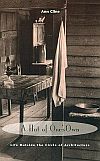 Cline,
Ann: A Hut of One's Own: Life Outside the Circle of Architecture. Cambridge, MA: MIT Press, 1997.
Cline,
Ann: A Hut of One's Own: Life Outside the Circle of Architecture. Cambridge, MA: MIT Press, 1997.
Ann Cline's book takes up where Joseph Rykwert's On Adam's House in Paradise leaves off at the primordial architectural meaning of the hut. Cline's search for meaning goes outside the architectural bounds to look at the dwellers and their experience. "This book is about eccentrics and recluses, hut dwellers and ne'er-do-wells, a story about lives scribbled in the margins of architecture and history, of huts and follies ... that would be forgotten but for the curious way misanthropy occasionally turns beneficent."
The book is an extended essay, not a history, but it does call for a close sense of identity with the subject and with those who have come before. The author dives into the subject of primitive huts, skimming the surface with Po-i and Shu-ch'i, the recluse archetype brothers of Chinese antiquity, with moderns like Gaston Blanchard and Thomas Merton, classics like Lao-tzu and Heraclitus, plus the great Japanese hut-dwellers Kamo no Chomei and Hoshida Kenko. The hut, she notes, has always been a projection of the self. When Heraclitus was chided on why he lived in such a small and humble abode, he responded, "Even here, the gods reside."
But Cline's narrative always calls for a close send of identity with present hut-makers and hut-dwellers, chiefly those who quietly aspire to the values of the hut. The book has personal anecdotes deftly mingled with history and theory for a rewarding excursion.
In the backyard of where she was living, Cline once decided to build a hut inspired by Kakuzo Okakura's The Book of Tea.
As my dwelling took shape, it began to shape my life as well. And when I sat inside reading the recluse poets, the terse simplicity of their record framed my own perception, one I likened to a camera recording a world of pure experience.
The hut has a sense of immediacy that no room-filled house can achieve. The hut focuses its dweller on immediacy and meaningfulness. "I had found the commodity of my dwelling through the poetry of its use," Cline concludes.
The hut addresses the core of ritual as a part of nature versus the supposed freedom of modernist thought and the architectural contrivances it pursues. The hut represents the convergence of ritual and naturalness, at the same time addressing cultural issues and practices.
With an agility larger structures can never match, huts bring together the physical environment with such disparate aspects of culture as necessity, fantasy, faith, and "life-style." The hut, then, may be humankind's supreme experiment.
This may seem a bold conclusion given the modesty of the hut throughout history, and the modest ambitions of its makers, but this is Cline's point, that the experiment in solitude and simplicity is bolder than any social or culturally-sanctioned experiments or projects, simply because the latter are contrived and unnatural, even anti-natural.
Thus recent times have seen disillusionment with art that expresses itself as mocking nature and sensibility. The avant-garde has exhausted itself. The incorporation of nature and ritual are necessary to overcoming what Cline calls the "ritual of hostility" in modern art galleries and in society at large. Here again, the tea house and tea ceremony is a good archetype.
If tea is tranquil, pure, and harmonious, then it is so only in contrast to the uncanniness of the world around it. In the midst of a frightening world, tea establishes a homely calm, the mirror opposite of a horror story read in a cozy room.
The understanding of culture and society is a necessary component for safeguarding the virtues that the hut gives us. Society is competition, contrivance, unnaturalness, and has created a culture of tenure, that is, a culture where certain things are approved by those in power as norms for the rest of us, what Nietzsche called "slave culture." Though we cannot here delve into Cline's rich discussion of culture, tenure, and uncanniness, her excellent arguments are the core of a philosophy of society and social psychology, and literally the center of the book.
Along the way, Cline offers anecdotes, historical insights, and personalities to amplify the story. Her hut built within a university academic building and the responses of students and others is one of those interesting tales.
Conclusion
Cline's book is an artful adventure into an intriguing subject, to an oft-overlooked part of culture, imagination, and self. Her concluding remarks are so persuasive and so well expressed that they can be presented without comment:
Huts are always fascinating but the huts of sophisticated cultures are especially so: from the huts of ancient recluse poets to those of ornamental hermits, from the casitas of the Bronx to the huts of seventeenth-century tea masters, from the shacks of the homeless to the follies of postmodern architectures. All these huts deconstruct the optimistic sophistication of their age. Then they rearrange it. ...
Nowadays [one] who wishes to experience the poetry of life ... should have a hut of one's own. ... Here, isolated from the wasteland and its new-world saviors, a person might gain perspective on life and the forces that threaten to smother it. ...
Only in a hut of one's own can a person follow his or her own desires -- a rigorous discipline, and one that the poet Gary Snyder calls the hardest of all, presupposing as it does self-knowledge while balancing free action and cultural taboo, knowing whether desire is instructive or the imprint of culture or if personal, whether such desires are the product of thought, of contemplation, or the unconsciousness.
Even if this hut is only one's normal abode inhabited in a different way, here in a hut of one's own, a person may find one's very own self, the source of humanity's song.
¶